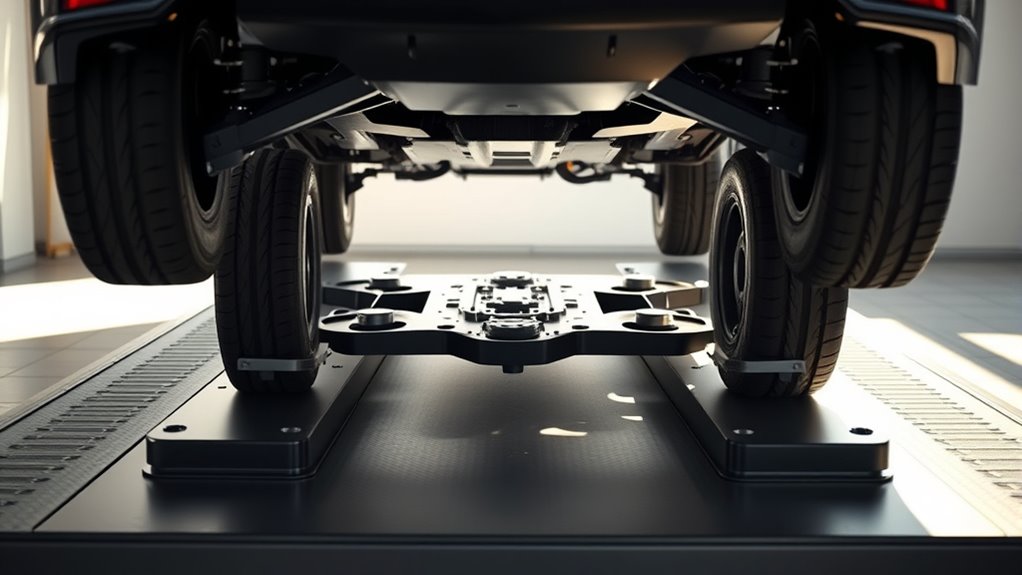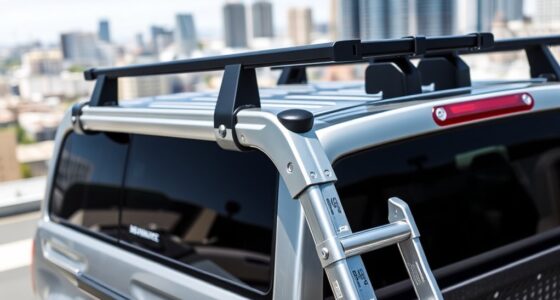When converting a vehicle, it’s essential to prioritize even weight distribution and keep the center of gravity as low as possible. Properly placing heavy components like batteries and motors near the ground and centered helps improve stability, handling, and safety. Shifting weight too high or rearward can make your vehicle top-heavy and increase rollover risks. Paying close attention to these factors guarantees your conversion remains safe and predictable—continue exploring to master this critical aspect.
Key Takeaways
- Proper weight distribution ensures vehicle stability, predictable handling, and safety during conversions.
- Heavy components placed higher or rearward increase the center of gravity, risking rollover and instability.
- Balancing weight evenly across the chassis and maintaining a low center of gravity improves control.
- Using scales to measure and adjust component placement helps achieve optimal weight balance.
- Proper weight distribution benefits suspension, tire wear, and overall vehicle safety after modifications.

When converting a vehicle, understanding weight distribution and the center of gravity is vital for safety and performance. These factors influence how your vehicle handles, accelerates, and brakes, especially after modifications. If you ignore them, you risk compromising stability, making your vehicle prone to tipping or losing control. To guarantee a safe and effective conversion, you need to be mindful of how weight is spread across the vehicle and where the center of gravity is located.
Start by visualizing how weight shifts when you add or remove components. For instance, installing heavy batteries, larger engines, or additional storage can greatly alter the balance. Placing heavy items higher up or toward the rear can raise the center of gravity, making the vehicle more top-heavy. This increases the likelihood of rollover during sharp turns or sudden maneuvers.
Adding heavy components high or rearward raises the center of gravity, increasing rollover risk during sharp turns.
Conversely, distributing weight evenly across the chassis helps maintain predictable handling and improves safety. Knowing where the center of gravity (CG) lies is vital because it determines the vehicle’s stability. The CG is the point where all the weight appears to be concentrated. When the CG is low and centered, your vehicle remains stable, even during aggressive driving.
If the CG is high or shifted forward or backward, it can cause the vehicle to become top-heavy or prone to fishtailing. During conversions, you should aim to keep the CG as low as possible by positioning heavy components close to the ground and centered between the axles. Additionally, understanding how weight distribution affects vehicle stability can guide your modifications for optimal results.
To achieve proper weight distribution, measure and plan carefully. Use scales to weigh each corner of your vehicle and ensure the weights are balanced. If you find one side or end is markedly heavier, consider relocating components or adding weight to the opposite side to balance things out. This process may require trial and error, but it’s well worth the effort for improved handling.
Additionally, consider the impact of your modifications on suspension and tire wear, which are directly affected by weight distribution. Ultimately, maintaining an ideal balance of weight and a low center of gravity will give you a safer, more controlled driving experience.
It will help your vehicle respond predictably, reduce the risk of accidents, and extend the lifespan of your components. When thinking about your conversion, prioritize these aspects from the start. Doing so ensures that your vehicle remains stable and reliable, no matter what modifications you make.
Frequently Asked Questions
How Does Uneven Weight Distribution Affect Vehicle Handling?
Uneven weight distribution can make your vehicle harder to control, especially during turns or sudden stops. When weight shifts to one side or the rear, it can cause instability, increased tire wear, and a risk of rollover.
You might notice steering becomes less responsive or your vehicle feels unbalanced. To stay safe, make certain your load is evenly spread, and consider adjusting your setup for better handling and stability on the road.
What Tools Are Best for Measuring Center of Gravity?
Think of tools as your vehicle’s health check-up. To measure the center of gravity accurately, you should use a scale system or a specialized CG measurement device.
These tools weigh each corner or use laser and sensor technology to provide precise data. By harnessing these, you’ll pinpoint the exact balance point, much like a skilled surgeon finds the heart of a problem—allowing you to make informed adjustments for ideal handling.
Can Weight Shifts Occur After Vehicle Conversion?
Yes, weight shifts can occur after a vehicle conversion. As you add or remove components, the vehicle’s weight distribution changes, which can alter its center of gravity.
Factors like cargo loading, modifications, or uneven wear can further shift weight over time. To maintain safety and handling, you should regularly check your vehicle’s balance and adjust loading or modifications as needed to guarantee ideal weight distribution.
How Do Different Terrains Impact Weight Distribution?
Different terrains considerably impact your vehicle’s weight distribution. On uneven surfaces like dirt or gravel, your vehicle might tilt or shift slightly, affecting how weight is spread across tires.
Uphill or downhill slopes can cause more weight to transfer forward or backward. Soft grounds like sand or snow may cause your vehicle to sink or settle unevenly, requiring you to adjust your driving to maintain balance and stability.
What Safety Precautions Are Essential During Weight Adjustments?
Think of yourself as a tightrope walker balancing high above. You must double-check your tools and surroundings before adjusting weight.
Always wear protective gear, verify the vehicle is on a flat surface, and use proper lifting techniques.
Keep a clear head, avoid rushing, and have a helper if possible.
These precautions help prevent accidents and maintain stability, keeping your conversion safe and secure, just like a skilled performer maintaining balance.
Conclusion
Understanding weight distribution and center of gravity isn’t just technical jargon; it’s the secret sauce that keeps your conversions safe and balanced. When you master these principles, you’re the captain of your vehicle’s stability, steering clear of disaster like a lighthouse guiding ships safely ashore. Remember, neglecting this balance is like walking a tightrope without a safety net—one misstep can lead to disaster. So, prioritize proper weight placement; it’s your best defense on the road.








